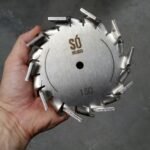Wood routers are versatile power tools that serve a fundamental role in woodworking, allowing artisans to shape, hollow out, and create intricate designs in various materials, primarily wood. Designed with a rotating cutting bit, a wood router can achieve a variety of profiles and edges on workpieces, creating everything from simple grooves to elaborate decorative patterns.
The basic mechanics of a wood router involve a motor-driven spindle that rotates cutting bits at high speeds. These bits come in various shapes and sizes, enabling woodworkers to perform tasks such as edge profiling, making joints, and inlay work. The depth of cut can be easily adjusted, providing flexibility and precision for each project. Wood routers can be operated in two main configurations: handheld and router table. Handheld routers offer mobility and control, while router tables provide stability and support for larger pieces, allowing for more intricate work.
Historically, wood routers have evolved significantly from their manual predecessors. The earliest versions of these tools were simple hand-held devices known as router planes, designed to smooth or hollow out surfaces with minimal effort. As technology advanced, electric models emerged in the mid-20th century, revolutionizing woodworking by significantly speeding up processes that would have taken hours by hand. Today, wood routers are indispensable tools for both hobbyists and professionals alike, due to their ability to enhance creativity and efficiency in woodworking projects.
Whether you are a beginner or a seasoned craftsman, understanding the functions and applications of wood routers can greatly expand your woodworking capabilities. As you delve into the world of routing, you will discover the vast array of possibilities that this essential tool has to offer.
Types of Wood Routers
Wood routers are versatile tools that come in various forms, each designed to cater to different woodworking needs. Among the primary types of wood routers are fixed-base routers, plunge routers, and router combos, each with its unique features and advantages.
A fixed-base router is characterized by a stable base that does not change position once set. This design provides excellent control for edge work, allowing woodworkers to create clean, precise edges. The fixed setting makes it ideal for tasks such as trimming and shaping where consistency is key. It often features adjustable speed controls, enabling woodworkers to tailor the router’s performance according to the materials being used. However, while fixed-base routers excel at certain tasks, they may not be the best choice for projects requiring deep or varied cuts.
Conversely, plunge routers offer enhanced versatility. This type of router allows the user to lower the bit into the workpiece at various depths, making it suitable for creating grooves, mortises, and inlays. The plunge mechanism provides more creative opportunities as woodworkers can adjust the depth of the cut on the fly, which is particularly beneficial in larger projects where precision is crucial. However, they may require a slightly steeper learning curve due to the complexity of their operation.
Router combos blend the features of both fixed-base and plunge routers. These units come with interchangeable bases, allowing woodworkers to switch between fixed and plunge modes seamlessly. This flexibility makes router combos an excellent investment for both beginners and experienced woodworkers, as they can tackle a broad range of tasks without needing multiple machines. The adaptability offered by combo routers positions them as a valuable addition to any woodworking workshop.
Key Features of a Wood Router
When selecting a wood router, it is crucial to understand the various features that can significantly impact its performance and utility in woodworking projects. One of the primary considerations is motor power. The motor’s horsepower (HP) determines the router’s capability to cut through different materials efficiently. Routers typically range from 1 to 3 HP, with higher-powered models best suited for larger, more demanding tasks. A powerful motor will allow for smoother operation and the ability to handle tougher woods.
Another key feature is the speed settings. Routers usually come with variable speed controls, allowing users to adjust the rotation speed to match the specific needs of the project at hand. A router with multiple speed settings is beneficial, as different applications—such as edge trimming versus intricate detailing—require varying speeds. Selecting a model that offers a good range of speeds can enhance both precision and finish quality.
Base type is equally significant when choosing a wood router. There are primarily two types: fixed base and plunge base. A fixed base router is ideal for straightforward tasks, providing stability for edge work, while a plunge base router allows more flexibility for mortising and carving, permitting users to “plunge” the bit into the wood. Depending on the intended applications, one may opt for one base type over another, or consider a combo kit that includes both.
Moreover, ergonomics should not be overlooked. A well-designed handle and grip protect against fatigue during extended use, allowing for greater control and precision. Safety features, such as automatic shut-off and dust shields, are also critical considerations to protect the user during operation. Overall, assessing these key characteristics will assist in selecting the most suitable wood router for both novice and professional woodworkers alike.
Common Uses of Wood Routers
Wood routers are versatile tools widely employed in woodworking, offering a range of applications that enhance both the functionality and aesthetics of wooden projects. One of the primary uses of a wood router is for edge profiling. This technique allows woodworkers to shape the edges of their boards, providing them with a polished finish that can significantly elevate the visual appeal of furniture, cabinetry, and decorative items. Various bit types can be utilized to achieve different edge profiles, such as chamfered, beveled, or rounded edges, catering to diverse design preferences.
Another common application of wood routers is the creation of grooves and dadoes. These cuts play a crucial role in joinery, enabling pieces to fit together seamlessly. For instance, a woodworker might use a router to create a dado in a cabinet side, providing a stable slot for a shelf to rest securely. The precision that routers deliver in making these cuts not only ensures a snug fit but also enhances the durability of the final product.
Wood routers are also instrumental in cutting decorative patterns. By utilizing specialized bits, woodworkers can engrave intricate designs onto surfaces or create raised panel effects that add character to doors or tabletops. This capability allows for a high degree of creativity, making routers invaluable tools for artisans looking to make their projects stand out.
Hollowing out areas of wood is yet another application where wood routers excel. This technique is often employed in the preparation of wooden bowls, signs, and various art pieces. The ability to remove material efficiently makes routers ideal for achieving consistent depth and shape, essential for both functional and decorative projects. The versatility of this tool is unequivocally evidenced in its widespread applications across different woodworking endeavors.
Router Bits: The Heart of the Wood Router
Router bits serve as the fundamental components of wood routers, playing a crucial role in defining the quality and precision of woodworking projects. Various types of router bits cater to diverse applications, allowing woodworkers to achieve specific profiles, edges, and finishes. Understanding the different types of bits and their uses is essential for maximizing the tool’s potential and achieving desired results in woodworking.
One of the most common types of router bits is the straight bit. This bit is predominantly used for making precise cuts, grooves, and dadoes. It is suitable for straight cuts along the grain of the wood, allowing woodworkers to create a variety of joint types. Additionally, straight bits are available in various diameters, enabling users to choose the optimal size based on the project requirements.
Round-over bits, on the other hand, are utilized to soften sharp edges and corners on wood projects. These bits are designed to create a rounded profile, enhancing both the aesthetic appeal and comfort of the finished product. By selecting the appropriate radius for the round-over bit, woodworkers can tailor their projects to achieve a desired look and feel.
Flush trim bits are invaluable for achieving clean, flush edges. They are often used for trimming laminate, veneer, or other materials to the exact dimensions of the underlying wood. This accuracy is essential for projects that require seamless, professional-grade finishes. Another important tool in the router bit arsenal is the specialty bit, which encompasses a variety of unique shapes and profiles, such as dovetail bits and edge-beading bits. These specialized tools enable woodworkers to create intricate designs and details that enhance the overall project.
Selecting the appropriate router bit greatly influences the outcome of a woodworking task. By understanding the nuances of each type, woodworkers can ensure that their projects meet both functional and aesthetic standards. Ultimately, the right choice of router bit is integral to producing high-quality woodworking outcomes.
Safety Tips for Using a Wood Router
Using a wood router can significantly enhance woodworking projects; however, safety should always be the top priority. Proper protective gear is essential for safeguarding against injuries while operating this powerful tool. Start by wearing safety goggles to protect your eyes from flying debris and a dust mask to avoid inhaling fine particles generated during routing. Hearing protection is also recommended, as routers can produce loud noise levels that may lead to hearing damage over time.
In addition to personal protective equipment, it is vital to familiarize oneself with safe handling practices. Always keep your hands a safe distance from the cutting area to prevent accidental contact with the router bit. Ensure that the workpiece is securely clamped down or stable on a workbench to avoid movement during the routing process. This is particularly important when making intricate cuts or working with smaller pieces, as even slight shifts can lead to mishaps. Additionally, check the router and its bits for any damage or defects before each use, as well-maintained equipment is less likely to malfunction and cause harm.
Furthermore, adopting techniques designed to prevent common woodworking accidents is essential when using a wood router. Always engage the router with the bit spinning at its maximum speed before making contact with the wood; this ensures a smoother cut and minimizes kickback risks. Maintain a firm grip on the router and push it in a direction that counters the bit’s rotation. This approach allows for greater control and reduces the likelihood of the router jerking away from your grasp. Lastly, avoid wearing loose clothing or jewelry that could get caught in the router’s moving parts. By adhering to these safety tips, users can confidently and effectively integrate the wood router into their woodworking repertoire.
Maintenance and Care of Wood Routers
Proper maintenance and care of wood routers are crucial for ensuring their longevity and operational efficiency. A well-maintained router not only enhances the quality of woodworking projects but also minimizes the risk of accidents during use. One of the fundamental practices in router care involves regular cleaning. After each use, it is advisable to wipe down the body of the router to remove dust and debris that can accumulate and impact performance. A soft brush or a vacuum attachment can be utilized for cleaning the motor vents, preventing overheating and potential damage to internal components.
Lubrication also plays a significant role in maintaining a wood router’s functionality. The moving parts, such as the motor bearings, should be lubricated according to the manufacturer’s recommendations, using appropriate oils or greases. This maintenance step is essential as it reduces friction and wear, ensuring smooth operation. Additionally, routine checks for wear and tear should be conducted. The router base, collet, and motor should be examined for any signs of damage or excessive wear, as these can affect performance and safety during operation.
Furthermore, it is imperative to care for the router bits, as they are integral to achieving precision in woodworking tasks. Router bits should be cleaned after each use to remove any resin or buildup. Storing them in a designated case helps protect their sharp edges and prolong their lifespan. Sharpening dull bits maintains their cutting efficiency, as using a dull bit can significantly strain the router motor and reduce the quality of the finished workpiece.
In summary, a proactive approach to the maintenance and care of wood routers involves regular cleaning, proper lubrication, routine inspections for wear, and diligent care of bits. By investing time in these practices, woodworkers can ensure that their tools remain in peak condition, ultimately leading to better project outcomes and greater safety in the workshop.
Troubleshooting Common Issues with Wood Routers
Wood routers are essential tools in woodworking, but users may encounter various issues that can hinder performance and precision. Understanding common problems and their solutions is crucial for maintaining the router’s functionality and achieving quality results in woodworking projects. Three prevalent issues include uneven cuts, excessive noise, and motor performance problems.
Uneven cuts are often caused by several factors, such as a dull bit, improper feed rate, or an incorrectly set depth of cut. To address this issue, first ensure that the router bit is sharp and suitable for the material being worked on. If the bit is worn, replacing it with a new one can significantly improve the quality of the cut. Additionally, adjusting the feed rate to match the material can prevent binding and help produce a more consistent cut. Finally, double-check the depth of cut settings; an inconsistent depth can lead to uneven surfaces.
Another common problem users experience is excessive noise during operation. While some noise is normal, an increase in volume can indicate issues such as worn bearings or parts becoming loose. Regular maintenance, including lubrication and tightening bolts and screws, can minimize excessive noise levels. If the noise persists, it may be advisable to inspect internal components or seek professional assistance to prevent further damage.
Motor performance problems can present as overheating, inconsistent speed, or failure to start. If the motor overheats, it may require a break and inspection of debris blocking airflow. Ensuring that the router is not overloaded during operation can also mitigate heating issues. Inconsistent speed may result from a faulty switch or electrical connections, necessitating examination of the router’s power supply. If the motor fails to start, checking the power cord for damage and verifying that the outlet is functioning correctly is essential.
By effectively troubleshooting these common issues, users can maintain smooth operation of their wood routers, ensuring optimal performance and enhancing the overall woodworking experience.
Conclusion
Wood routers serve as an indispensable tool in the realm of woodworking, providing versatility, precision, and countless possibilities for both novice and seasoned craftsmen. Their ability to shape, edge, and hollow out wood allows for the creation of intricate designs and professional-quality results in various woodworking projects. By mastering the use of a wood router, individuals can elevate their craftsmanship, explore innovative techniques, and produce custom pieces that reflect their unique style.
The importance of investing in a quality wood router cannot be overstated. A durable and efficient router enhances productivity while ensuring consistency across projects. With a variety of bits and attachments available, wood routers can handle an impressive range of tasks—from simple edge finishing to complex decorative work. This makes them a vital addition to every woodworker’s toolkit. Furthermore, the adaptability of a wood router supports the vision of those looking to experiment with different materials and methods, whether it be furniture making, cabinetry, or artistic endeavors.
As woodworking continues to attract enthusiasts and professionals alike, it is crucial to recognize the role of routers in facilitating innovation and creativity. Exploring the vast possibilities that wood routers offer can lead to new techniques and improved job outcomes. Thus, when considering the tools that play a pivotal role in shaping quality woodworking projects, the wood router remains a top contender. Investing in a reliable router tailored to your specific needs can transform your woodworking experience, allowing for a greater exploration of this timeless craft.


